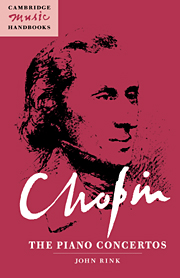5 - Chopin's third concerto
Published online by Cambridge University Press: 18 December 2009
Summary
Contexts
Chopin's enthusiasm for the stile brillante waned rapidly during his early years in Paris. Only a handful of virtuoso pieces follow the two concertos – among them, the Grand duo concertant for piano and cello on themes from Meyerbeer's Robert le diable (1831), the Variations brillantes Op. 12 on a theme of Hérold (1833) and the Rondo Op. 16 (ca 1833). None of these comes close to the concertos conceptually or expressively, and it is understandable why, having brought the stile brillante ‘to perfection’, Chopin should henceforth have favoured the more individual artistic style he had forged in Warsaw in the late 1820s and in Vienna and Paris from 1830 onwards. Nevertheless, his ongoing exploitation of virtuoso textures and procedures in other musical contexts remains one of his most significant compositional achievements. Starting with the Etudes Op. 10, Chopin utterly transformed the conventional gestures of the brilliant style, deriving new powers from the archetypal alternation between lyricism and display, and employing virtuosity for profoundly expressive purposes – as in the ‘finales’ of the four ballades, which employ a ‘white heat of virtuosity’ to ‘exorcise earlier conflicts and tensions’. These and other large-scale works – including the scherzos, fantasies and sonatas – indirectly draw upon the precedent set by Op. 11 and Op. 21, which themselves stand apart from the conventional by reinterpreting the traditions that shaped them.
Against this background, Chopin's Allegro de concert, published in 1841, comes as a surprise in its blatant exploitation of the stile brillante, only partially mediated by the stylistic consolidation of the 1830s.
- Type
- Chapter
- Information
- Chopin: The Piano Concertos , pp. 88 - 100Publisher: Cambridge University PressPrint publication year: 1997
- 1
- Cited by

